#German Heinkel He 111 bombers
Text
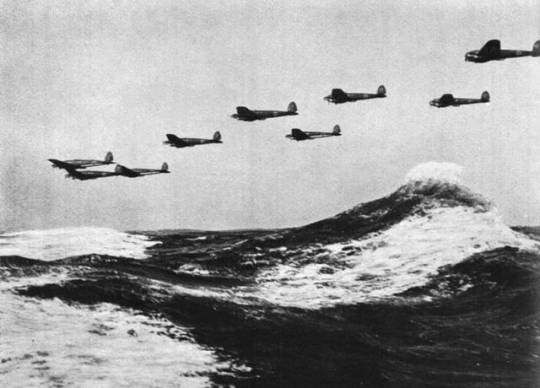
"THE SOUND OF DISTANT AIRCRAFT GROWS LOUDER AND LOUDER...!"
PIC(S) INFO: Spotlight on a reportedly composite photograph of German Heinkel He 111 bombers over the English Channel, flying low in order to avoid all possible British radar frequencies, c. 1940.
[Who caught my 1981 DISCHARGE reference? War is a black hole to avoid!]
Source: www.reddit.com/r/WWIIplanes/comments/111q7fb.
#German Heinkel He 111 bombers#WWII#War photography#Luftwaffe Bombers#German Luftwaffe#Bomber Squadron#Battle of Britain#Luftwaffe#1940s#English Channel#Military history#German Bombers#1940#Bombers#Heinkel He 111 bombers#World War 2#War history#Composite photography#Forties#40s#Battle of Britain 1940#World War II#Heinkel Bombers#Nazi Germany#Photography#Aviation
25 notes
·
View notes
Text

A RAF Supermarine Spitfire Mark I fighter flies beneath a German Heinkel He-111 bomber after attacking it over England.
28 notes
·
View notes
Photo
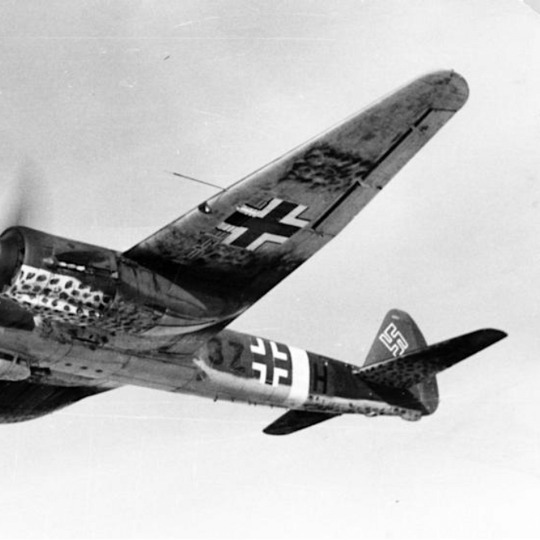
Junkers Ju 88
The Junkers Ju 88 was a two-engined medium bomber plane used by the German Air Force (Luftwaffe) throughout the Second World War (1939-45). Ju 88s were involved in the Battle of Britain and London Blitz as bombers, but this versatile aircraft saw action in many other theatres of the war, primarily as a dive bomber and a night fighter.
Design Development
After much debate between the German high command and the Nazi leader Adolf Hitler (1889-1945), the Luftwaffe bomber command (Kampfwaffe) was obliged to adopt the position that bombers should primarily be used strategically to assist ground troops. This meant that unlike, say, the British Royal Air Force, the Luftwaffe concentrated not on heavy bombers but building squadrons of more versatile medium bombers.
In August 1935, aeronautical companies were invited to provide an answer to the German Air Force's requirement for a two-engined, medium-sized and high-speed bomber (Schnellbomber). Junkers came up with the Junkers 88, with various prototypes given a V designation plus a number 1 to 5. The first prototype, the Ju 88 V1, flew in December 1936 and impressed with its high speed. By March, the Ju 88 V5 was capable of speeds of over 300 mph (500 km/h) and so broke several records.
The decision in 1937 to give the Ju 88 a dive-bombing capability meant that the design process now became fraught with delays and constant revisions. As the historian J. Holland notes, "some 25,000 changes were made to the original design" (216). Most significant of these changes, perhaps, was the strengthening of the wings to take the force which resulted from steep dives, the addition of brakes to arrest the plane at the nadir of the dive, and the lengthening of the fuselage to admit extra crew members. The consequence of all this was that the plane ended up being much heavier and slower than the original plan, a situation that led Field Marshall Erhard Milch (1892-1972), one of the founders of the Luftwaffe, to disparagingly describe the Ju 88 as a "flying barn door" (ibid). The problems of weight and speed were partially alleviated by adding rocket boosters for takeoff when carrying heavier bomb loads. The design changes kept on coming, too, notably an increase in the wingspan. As a result of the complex design, the Ju 88 took more time to build than many other aircraft types.
Introduced into Luftwaffe service in September 1939, just as WWII started, the Ju 88s' challengers as the medium bomber of choice within the Luftwaffe were the antiquated and poorly armed Dornier Do 17, the equally vulnerable but faster Dornier Do 215, and the tried and tested Heinkel He 111, which was overall the best of the three at the beginning of the war. The Junkers Ju 88 was smaller than the other three medium bombers but faster than the He 111 and the Do 17, and yet it was capable of carrying as heavy a bomb load as the He 111. As a consequence, gradually the Ju 88 took over from the He 111 as the bomber of choice but both saw service right through the war. All of these planes had two engines, which fundamentally restricted their bomb loads and range compared to Allied heavy bombers like the B-17 Flying Fortress and Avro Lancaster bomber.
The upside of its checkered design history was that the 1940 version of the Ju 88 was more versatile than originally planned, making it perhaps the most versatile of any aircraft of any air force in WWII. The Ju 88 could perform as a bomber, dive-bomber, and night fighter. Other duties performed by the Ju 88 included long-range reconnaissance (when they were fitted with extra fuel tanks, radar, and cameras), attacking shipping, and minelaying at sea. Finally, one distinct advantage of the Ju 88 was that its frame was built in such a way that it could withstand tremendous punishment from enemy fire. Factories dedicated to Ju 88 production included those at Brünn (now Brno in the Czech Republic) and Graz and Vienna in Austria. Air forces which operated Ju 88s besides the Luftwaffe included the Finnish, French, Hungarian, Italian, and Romanian.
Continue reading...
21 notes
·
View notes
Text

A German Heinkel He-111 H-5 (serial number WNr.3452), shot down by Allied anti-aircraft fire - Kongsbakktinden mountains, Narvik - 28th May 1940. The bomber belonged to the 2./Kampfgruppe 100. Of the crew, two were killed and two were captured.
#world war two#1940s#worldwar2photos#history#ww2#wwii#ww2 history#wwii era#world war 2#ww2history#aviation#1940#luftwaffe#heinkel he111#heinkel#narvik#norway
93 notes
·
View notes
Text
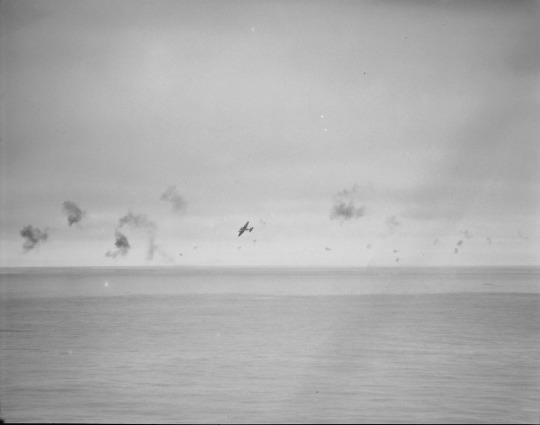
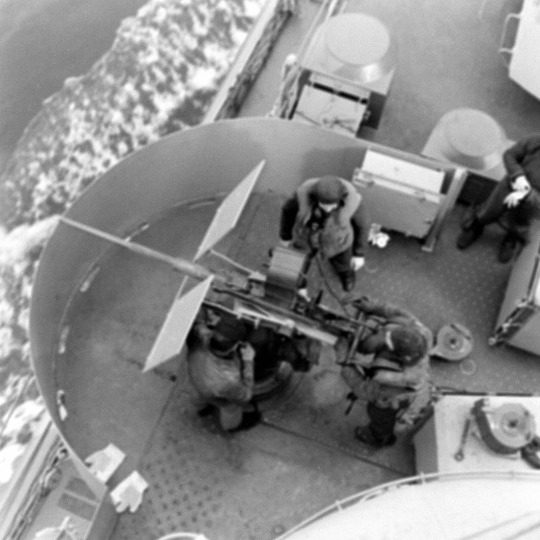
"USS Wainwright (DD-419) fires on Luftwaffe He 111 Torpedo Bombers attacking Arctic Convoy PQ-17 on July 4, 1942.
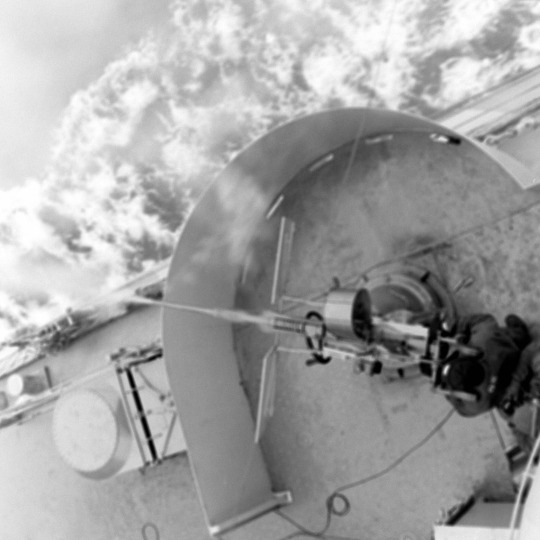
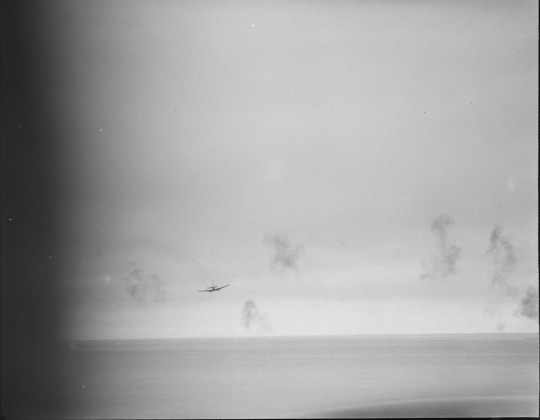

Originally part of the Cruiser Covering Force, on the afternoon of July 4th, USS Wainwright joined the convoy to refuel from the tanker Aldersdale. Before starting the refueling, Luftwaffe He 111s attacked and Wainwright assisted the convoy in repulsing two consecutive attacks by the torpedo bombers. During an ensuing dive-bombing attack, she evaded an attack by Ju 88s with the nearest bomb landing at least 150 yards away.

After the dive-bombing attack, a two-hour lull in the action allowed Wainwright to resume refueling, but the Luftwaffe returned around 1820hrs with 25 He 111s. The Heinkels divided themselves into two groups for the attack, Wainwright's fire on one of the two groups proved so effective that only one managed to penetrate her defenses to make the torpedo drop between Wainwright and the convoy. The other He 111s in that group dropped their torpedoes from further out that resulted in excessive torpedo runs to the convoy that the ships in the convoy easily evaded.
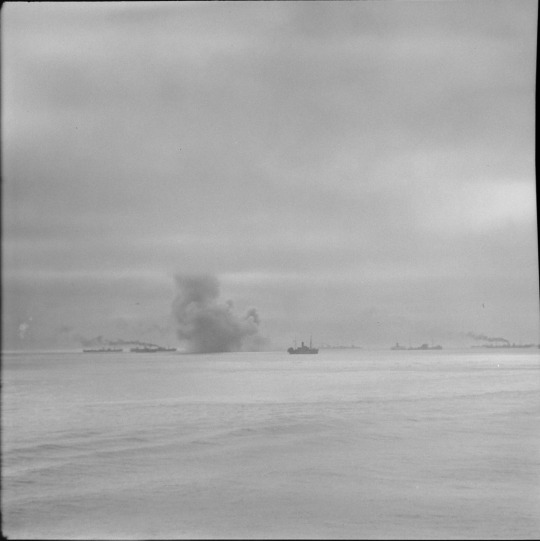

Torpedos from the 2nd group of He 111s hit two ships in the Convoy; William Hooper and Azerbaidjan.
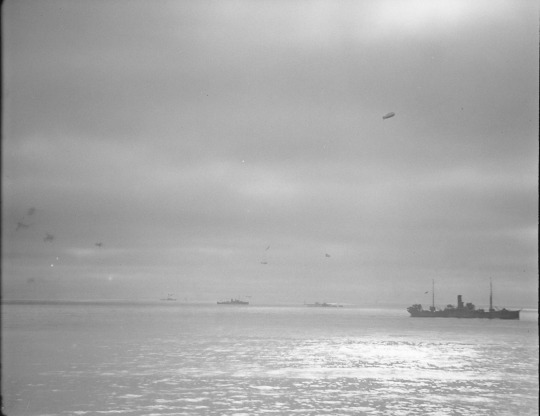
Afterwards, when Convoy PQ-17 was ordered to scatter due to a supposed German surface ship threat that included the Battleship Tirpitz, the convoy lost 24 of its 35 merchant ships to combined German aircraft and U-Boat attacks."
Photographed by Frank Scherschel for LIFE Magazine. Identified by Peter DeForest.
LIFE Magazine Archives: 115781364, 115781365, 115781377, 115781380, 115781378, 115781389, 115781390, 115781391, 115781379
#USS Wainwright (DD-419)#USS Wainwright#Sims Class#Destroyer#July#1942#PQ-17#convoy#Atlantic Ocean#united states navy#us navy#navy#usn#u.s. navy#my post
29 notes
·
View notes
Text
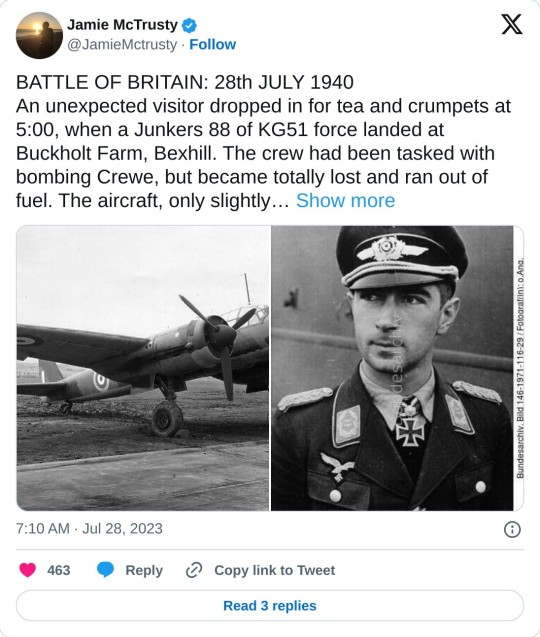
☝️ damaged, was repaired and later test flown at Farnborough before being used as a spares source for two other Ju88s of the RAF’s Enemy Aircraft Flight.
Despite excellent weather, which had led to extra RAF squadrons being moved to forward airfields, there was little Luftwaffe activity until shortly after 13:30, when a large raid was detected heading towards Dover. Spitfires from 74 and 41 Squadrons were scrambled, along with Hurricanes from 257 and 111 Squadrons. The German bombers turned back, but a sharp engagement with their Bf109 escort ensued. This resulted in two 109s crash landing in France and another being destroyed, but three Spitfires were shot down. Two Heinkel 59 air-sea rescue aircraft were also lost, to the Hurricanes of 111 Squadron.
One of the Bf109s which crash landed was that of noted Luftwaffe pilot Werner Mölders, on his first sortie over Britain with JG51. He was hit in the leg by splinters, and although the wounds were relatively minor, he did not return to combat for a month. It was long believed that his assailant had been the famous ‘Sailor’ Malan, of 74 Squadron, but recent research suggests that it was actually Flt/Lt John Webster of 41 Squadron.
2 notes
·
View notes
Photo
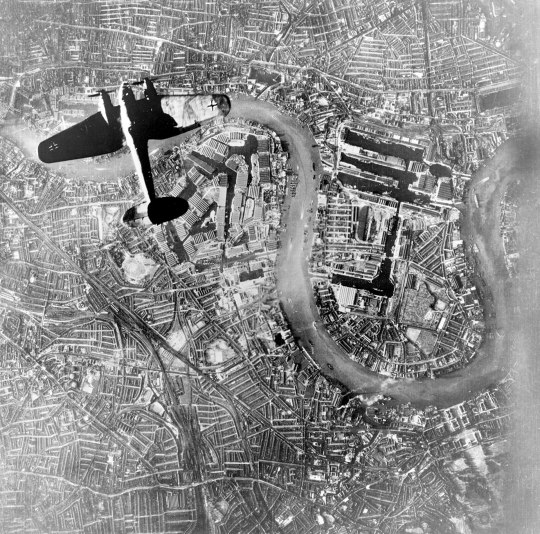
A German Luftwaffe Heinkel He 111 bomber flying over Wapping and the Isle of Dogs in the East End of London at the start of the evening raids of The Blitz. 7 September 1940 https://t.me/InterestingasfuckBackup/58234 #interestingasfuck #rinterestingasfuck #interestingasfuckreddit #interestingasfucksubreddit #r_interestingasfuck
2 notes
·
View notes
Photo
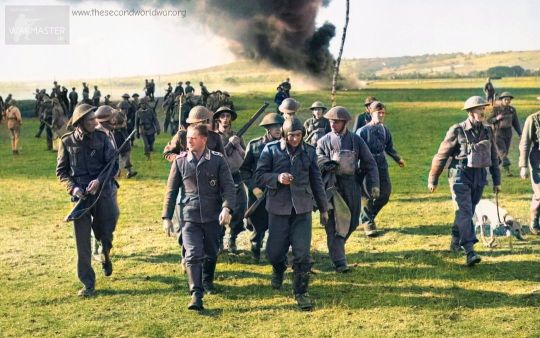
German airmen, who parachuted from a shot-down Heinkel HE-111 bomber (remains smoking in the background) are marched off by the Home Guard in Goodwood, Sussex, 12th September 1940. #secondworldwar #ww2 #worldwartwo #worldwar2 #war #history #militaryhistory #military #colourised #colorized #colourisedhistory #colorizedhistory #color #colour #colorizedhistoricalphotos #colorization #colourisation #retro #goodolddays #classic #goldenoldies #colorizedphoto #colourisedphoto #sussex #sussexgram #sussexhistory #sussexatwar #raf #luftwaffe #goodwood Photo by Fox Photos/Hulton Archive/Getty Images
0 notes
Text
a collection of my favourite friendly-fire incidents, in no particular order
14–18 August, 1944: During the march to close the Falaise Pocket, the South Alberta regiment of the 4th Canadian Armoured Division sustained over 57 casualties from six different strafing attacks performed by RAF Spitfires. Despite the smoke columns from their destroyed vehicles, as well as the deployment of yellow signalling smoke -- the designated colour for friendly ground forces -- the strafing runs continued. One of the regimental officers in the 4th Divison flew off the fucking handle, and ordered his entire battery of self-propelled Crusader Anti-Aircraft tanks to fire on nearby RAF aircraft. [1]
2 January, 1966: An American Cessna O-1 Bird Dog flying over Bao Trai (now Hậu Nghĩa) was struck mid-air by indirect fire from an ANZAC howitzer battery, firing at a nearby NLF position. Like the fucking shells were falling, and this moron flew straight into the barrage and got hit. Mid-air. The tail of the plane separated from the airframe, and the pilot died on impact with the ground. [2]
10 May, 1940: A German Heinkel He-111 bomber took off from an airstrip to bomb the French city of Dijon during the Battle of France. However, due to some fucking insane calculation errors, they managed to fly back into Germany, and drop 69 bombs on the city of Freiburg instead, killing 57 German civilians. Of course the Nazis didn’t want to admit that their own city was bombed by the Luftwaffe, so Hitler blamed Churchill for “Coordinating terrorist attacks”. It’s also of note that the bombing occurred somewhere in the afternoon/evening, and visibility was good enough that the bomber crew identified landmarks on the ground -- they just mistook all of them for French ones. [3] [4]
June/July, 1801: During the Battle of Algeciras Bay, the two Spanish Santa-Ana class ships of the line, Real Carlos and San Hermenegildo, were sailing the Strait of Gibraltar. During foggy, nighttime conditions, the British HMS Superb sailed between the two Spanish ships. While attempting to pursue the Superb, both Spanish ships mistook each other for the Superb, and engaged with cannons. Both Spanish ships were sunk, and 1,700 sailors died. The Superb sailed away without a scratch. [5]
31 January, 1915: At the Battle of Bolimów, the German Ninth Army launched the first-ever gas attack of WWI on the Russian Second Army. However, upon the Ninth Army firing 18,000 bromine gas shells at Russian lines, it became clear that the Germans did not know how wind worked, and all of the gas blew backwards into German lines. There are no official casualty counts, but it’s suspected they were rather low due to the cold temperatures freezing the xylyl bromide in the gas. [6] [7]
14 April, 1942: In an RAF demonstration of “tactical airpower” in Wiltshire, went awry when a Hawker Hurricane fighter mistook the audience of the demonstration, for the target-dummies he was supposed to be hitting. The pilot strafed the observing crowd with his machineguns and killed 25; injured 71. Unfortunately, this was a rehearsal the day before Winston Churchill was supposed to be apart of that crowd. Fucking lmao. [8]
13 September, 1969: I don’t have a lot of details on this one, but apparently some British NCO stationed in Northern Ireland got shot in the face by one of his own men, while on the phone with his wife inside a British FOB. I can barely find anything more on this, but I will say that every account of FF I’ve found from the Troubles was dumbass Brits shooting each other unprompted, and I think that’s wonderful. [9]
1 January, 1945: Due to Allied airpower in France following the Battle of Normandy, and the dwindling fuel reserves of Nazi Germany, the Luftwaffe took a largely defensive posture during 1944/1945. However on New Years Day, 1945, the Luftwaffe made a final attempt at gaining air superiority in Operation Bodenplatte. Of course, they managed to completely fuck up this surprise attack, as they completely neglected to tell any German Anti-Aircraft crews about it. So at 08:30, German squadrons took off and were almost immediately shot down by their own anti-aircraft batteries. Roughly 300 aircraft were lost, and only a fraction of those were from scrambled Allied fighters. This is the largest single-day loss for the Luftwaffe in the entire war [10]
21-22 September, 1788: The whole Austro-Ottoman War was a shitshow, but the Battle of Karánsebes absolutely takes the cake; imagine a bar-fight with muskets. The Austrian army of about 100,000 men was making camp outside of Karánsebes, while a detachment of Hussars forded the Timiș River to scout for Ottoman soldiers. They didn’t run into any enemy during the patrol, but did run into a group of Romani merchants, who sold them schnapps. The Hussars start having a little party by the riverbank, which attracts the attention of a number of infantrymen from the main camp. The infantry began demanding to have some of the schnapps, which the hussars refused -- then it all goes fucking sideways. A shot rings out in the crowd; one of the hussars has been shot by an infantryman. The Hussars return fire, and then someone in the crowd yells “Turks!”. The crowd disperses, the majority heading back across the river, towards the camp, where the Corps Commander thought they were under attack by Turkish cavalry, and ordered all of his artillery to open fire on the hussars. Thinking they’re under attack in the middle of the night, the camp garrison starts firing at each other indiscriminately -- even better, since the Austrian army was comprised largely of mercenaries and multiethnic groups from the Balkans, none of them understood each other, so they couldn’t tell each other they were allies. Shit, even the guys speaking German were misunderstood; apparently when the Corps Commander called for everyone to halt, he was misheard as saying “allah”. Oh, and the archduke of Austria got thwacked off his horse and fell into the river, fuckin idiot. The entire army, thinking they were overrun with Turks, fled the town and went into a full-retreat. Two days later, the Ottomans found the massacre and just occupied the town with no resistance. Final estimates on the casualties were roughly 150 dead, 1,200 wounded and 563 missing. [11]
Cited Sources Below
1. Graves, Donald E. (1998). South Albertas: A Canadian Regiment at War. Toronto: Robin Brass Studio. ISBN 1-896941 -06-0.
2. Bob Breen, Bob (1988) First to Fight: Australian Diggers, NZ Kiwis and US Paratroopers in Vietnam, 1965–66, Allen and Unwin, Sydney; ISBN 0-89839-126-1
3. Gerd R. Ueberschär: Freiburg im Luftkrieg 1939–1945. Ploetz, Freiburg im Breisgau 1990, ISBN 978-3-87640-332-8
4. Big Deal, Der Spiegel 17/1982
5. Lettens, Jen. (2009, January 26). San Hermenegildo (+1801). wrecksite.Eu. https://www.wrecksite.eu/wreck.aspx?17094
6.Duffy, Michael (2005-12-22). "The Battle of Bolimov, 1915". First World War.com. Archived from the original on 3 September 2006. Retrieved 2006-08-15.
7. Smith, Gordon (December 2000). "Military Campaigns of World War 1—Russia". Naval-History.net. Archived from the original on 2006-08-13. Retrieved 2006-08-15.
8. Frampton, Will (11 April 2012). "Memorial to be unveiled to personnel killed in Imber friendly fire incident". Wiltshiretimes.co.uk. Retrieved 20 August 2016.
9. p.37, Operation Banner: The British Army in Northern Ireland 1969 to 2007, Nicholas Van der Bijl, Pen and Sword, 2009
10. Says:, S., Says:, S., Says:, M., Says:, C., Says:, B., Says:, T., . . . Says:, T. (2018, October 11). Fatal errors – the Worst friendly fire incidents of World War Two. Retrieved April 15, 2021, from https://militaryhistorynow.com/2012/09/19/fatal-errors-the-worst-friendly-fire-incidents-of-world-war-two/
11. Mayer, Matthew Z., "Joseph II and the campaign of 1788 against the Ottoman Turks," Master's thesis: McGill University (Montreal, Quebec, Canada), 1997 ; see especially pp. 61–62. Available at: McGill University (Montreal, Quebec, Canada)
474 notes
·
View notes
Photo

A Heinkel He 111 (P or H) from KampfGeschwader (Battle Wing) KG 55 “Greif” is passed by a Spitfire during an anti-shipment attack.
Battle of Britain 1940.
#ww2#wwii#luftwaffe#kampfgruppe#battle wing#battle of britain#1940#heinkel#he 111#anti ship wars#spitfire#supermarine spitfire#ww2 aircraft#ww2 history#raf#royal air force#german airforce#medium bomber
23 notes
·
View notes
Photo
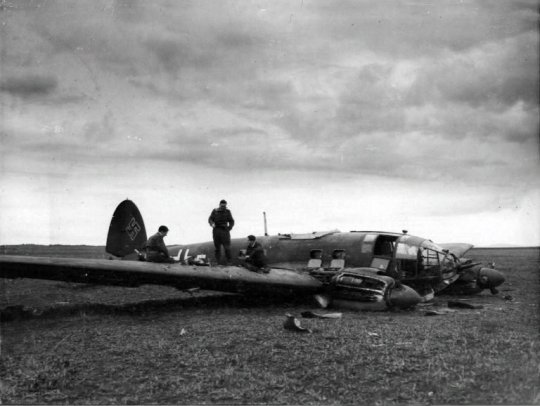
British pilots inspect a German Heinkel He-111 bomber, shot down in Algiers
32 notes
·
View notes
Text

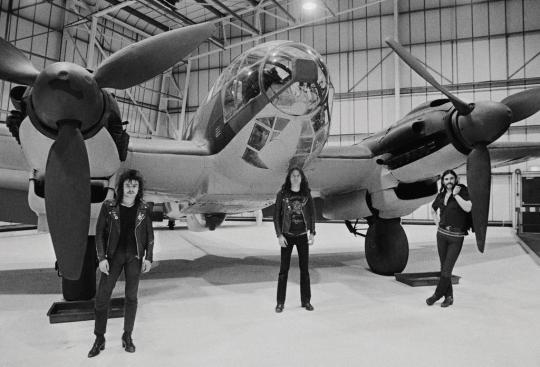


READY FOR TAKE-OFF -- INTO THE ROCK & ROLL STRATOSPHERE AND BEYOND.
PIC(S) INFO: Spotlight on English rock and roll/metal punk group MOTÖRHEAD posing next to a Heinkel He 111 bomber at the Imperial War Museum in London, c. 1979. 📸: Chalkie Davies.
In memoriam -- Phil "Philthy Animal" Taylor, "Fast" Eddie Clarke, Lemmy Kilmister, and may God rest all their souls forever. HAIL!!
Source: www.pressreader.com/uk/classic-rock/20190528/283059825843608.
#MOTÖRHEAD#MOTÖRHEAD 1979#1979#Rock and Roll#Imperial War Museum#London UK#Power Trio#Metal punk#Rock 'n' roll#Bomber#Bomber 1979#Heinkel He 111#World War II#German Luftwaffe#World War 2#70s#Lemmy Kilmister#Philthy Animal Taylor#Aviation#Fast Eddie Clarke#Luftwaffe#Aircraft#Guitarist#Drummer#1970s#London England#Motörmusic#WWII#Heinkel He 111 bomber#Punk metal
5 notes
·
View notes
Text
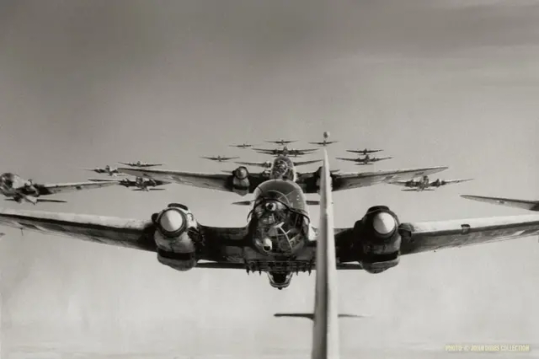
Formation of German Heinkel He 111 bombers en route to their target, somewhere over Russia, 1943.
26 notes
·
View notes
Photo

Heinkel He 111
The Heinkel He 111 was a medium two-engined bomber plane used by the German Air Force (Luftwaffe) during the Second World War (1939-45). Heinkel He 111s contributed significantly to such campaigns as the Battle of France, the Battle of Britain, and the London Blitz, but were increasingly replaced from 1941 by the more modern and faster Junkers Ju 88.
Early Designs
The He 111 was first imagined as a civil airliner for Lufthansa, but when the Nazis came to power in Germany in 1933, production turned more openly towards machines of war. The Treaty of Versailles after the First World War (1914-18) had strictly forbidden Germany from possessing a military air force, but the German leader Adolf Hitler (1889-1945) went ahead and formed several secret squadrons anyway. Another way around the restriction was to build civilian craft that could easily be converted into bombers; the He 111 fell into this latter category.
Designed by Siegfried and Walter Günter and based on their earlier He 70 model, the He 111 bomber was manufactured by Heinkel, an aviation company founded and run by Ernest Heinkel (1888-1958). Heinkel had extensive experience with military aircraft, having built planes for the German Navy and the Austro-Hungarian army in the First World War. After much debate between the German high command and Hitler, the Luftwaffe bomber command (Kampfwaffe) was obliged to adopt the position that bombers should primarily be used strategically to assist ground troops. This meant that unlike, say, the British Royal Air Force, the Luftwaffe concentrated not on heavy bombers but building squadrons of more versatile medium bombers. The He 111 was the result of this thinking, that is, an aircraft with multiple tactical uses, but one not capable of carrying very heavy bomb loads that could deliver a significant blow to ground targets. The He 111 was hampered, too, by its short range as the theatre of war expanded and Germany sought to bomb Britain.
The first He 111 prototype model was flown in February 1935 at the Heinkel works at Rostock-Marienehe (now Rostock). Design tweaks included shortening the wings and improving stability. At this stage, the aircraft were powered by BMW engines. By 1936, Lufthansa was flying a number of He 111s as airliners and transport planes. The aircraft achieved the title of 'the world's fastest passenger plane' when a top speed of 250 mph (402 km/h) was recorded.
Meanwhile, military versions were being built, which had a slightly longer nose and machine-gun armaments. The bomber version was not powerful enough for requirements, though, and the BMW engines were replaced with Daimler-Benz engines (later models replaced these again, this time with Junkers Jumos). By 1937, and thanks to a large ministerial order, Heinkel built a dedicated factory for He 111s at Oranienburg close to Berlin. Further developments followed such as increasing the fuel capacity and making the tanks self-sealing, increasing the armour protection, making a straighter wing so that factory production was more efficient, moving the forward gunner a little to the side to give the pilot better visibility, and giving more transparency to the cockpit area and nose section, a distinctive feature of the He 111.
Heinkel He 111s were first used in action by German forces participating in the Spanish Civil War (1936-9) in the Legion Condor units and then throughout the Second World War by the Luftwaffe. Other air forces which used He 111s included the Chinese, Hungarian, Romanian, Slovakian, Spanish, and Turkish.
Continue reading...
23 notes
·
View notes
Photo
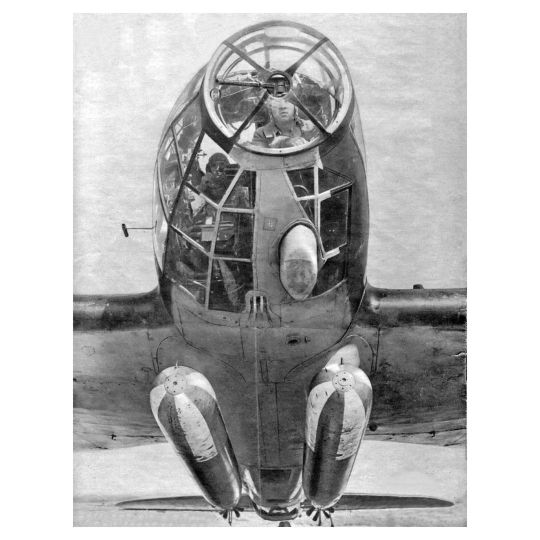
German Heinkel He 111 two-engine bomber bomber wing 26 (KG 26) with its crew and two torpedoes. https://www.instagram.com/p/CSvTtCUN4qM/?utm_medium=tumblr
35 notes
·
View notes
Text
Robert Redford’s Porsche 904 GTS Is For Sale
Robert Redford’s Porsche 904 GTS Is For Sale
#porsche #porsche904 #aircooled #racecar #robertredford #racing #classiccar #vintagecar #car #cars
The Porsche 904 GTS was unveiled in 1963 as the German company’s primary sports racing car. It was powered not by their new flat-six but by the tried and tested four-cam flat-four, and it was built with a fiberglass body bonded to a steel ladder chassis.
Interestingly the fiberglass bodies were built by Heinkel – the same company that had built the Heinkel He 111, the primary bomber used by the…

View On WordPress
6 notes
·
View notes